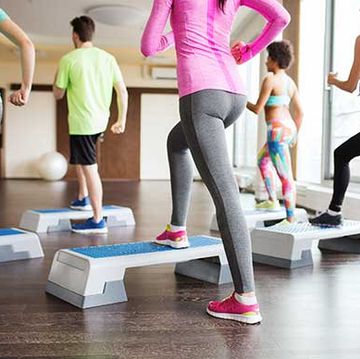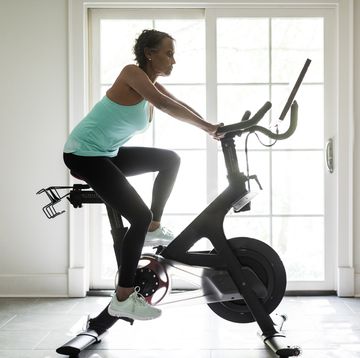Photo by Youra Pechkin/Getty Images
A treadmill comes in handy for those dark, cold days when you can't gather up the motivation to walk or run outside. Using one seems simple enough, but you can still develop bad habits that can sabotage your results—and even lead to injury. Here are the 10 most common treadmill blunders and how to correct them:
1. You wear the wrong shoes.
This is not a good time to be vain—so when selecting your sneakers, go for function before style, says Michele Olson, PhD, CSCS, professor of exercise science at Auburn University. Look for shoes with extra padding in the soles to protect your heels and foot bones from the high impact of each foot strike. Keep in mind, however, to use them only for walking or running—not dance or cardio classes. "Higher-soled running shoes can increase your risk of turning over an ankle in dance class," says Olson. "If you do hill or speed walking, look for a more moderate height in the outer sole, such as the Nike Free Runner." (Find a new pair with our handy sneaker guide.)
2. You look at your feet.
Looking at your feet while walking on the treadmill can cause you to lose your balance, says Olson. "It can also strain the back of your neck and misalign the rest of your body, causing your hips to poke out behind you”—which stresses your spine, hips, and knees. Gaze straight ahead and keep your shoulders level and chest open. Your hips, knees, and low-back will follow, making a relatively straight line from the head to your feet.
3. You slap your feet down.
Photo by Yan Lev/Getty Images
Landing flat-footed can cause muscle strain. "You end up leaning backward as the belt goes forward, which strains back muscles from the force generated through your hips and back," says John Higgins, MD, associate professor of medicine at The University of Texas Health Science Center at Houston and director of exercise physiology at the Memorial Hermann-Texas Medical Center. "This could also cause you to lose your balance." Be as vertical as you can and walk or run as you would normally. Land on your midfoot or the ball of your foot—not your heel.
4. You stick with one routine.
It may be comfortable doing the same treadmill workout day after day, but over time you'll burn fewer calories as your body adapts and muscles become more efficient. Every four weeks change at least one aspect of your workout, suggests Olson. Try the elliptical or the stair climber, or take your walk outside. "Routine changes also help prevent muscle and joint strains from the repetitive stress of pulling and pushing the muscles at the same angles over and over again," says Olson. (Here's how to burn even more calories on the elliptical.)
5. You arms are all over the place.
Swinging your arms by winging them out to the sides or criss-crossing them in front of you as you walk is simply not efficient, says Higgins. "You burn up energy with your arms and won't be able to work out as long." Keep your arms by your sides until you get to higher speeds, says Higgins. Once you reach a jog, keep arms bent parallel to each other and at 90-degrees, which helps with the rotation of your torso. "Keep your arms loose, not tight or tense," says Higgins.
6. Your stride is too long.
Stretching out your legs in an effort to cover more ground sacrifices form and efficiency, says Higgins. Someone who overstrides will appear to be leaping high with each stride. "You burn up a lot of extra energy, so you can't work out as long and you also increase the risk of injury." You could also hit the front of the treadmill frame, which can cause you to fall. The most efficient way to run is three steps per second, says Higgins. "You should barely lift your foot off the ground."
7. You hold the bars.
Photo by PNC/Getty Images
Walking on an incline burns more calories than walking on level ground—unless you sabotage results by hanging on, says Higgins. "You burn fewer calories when you support part of your own body weight." Walk naturally on the incline as you would normally walk up a hill outdoors. "You should be nearly vertical with a slight lean (five degrees), not way forward so you're grabbing onto the front of the treadmill," says Higgins. Your feet should come down underneath your center of gravity, not far out in front.
MORE: Your 10 Biggest Walking Pains, Solved!
8. You hunch forward.
If you lean too much in any direction, your body will naturally work to keep its balance, says Benjamin Figueroa, senior exercise physiologist at Fox Rehabilitation in Cherry Hill, NJ. Hunching forward can cause you to develop an anterior tilt or excessive forward lean, which can cause you to lose your balance and may contribute to lower back pain. Keep a solid upright posture, which includes engaging your core muscles. If you can't maintain good posture, slow down the treadmill speed, says Figueroa.
9. You overdo it.
Excess muscle soreness, elevated resting heart rate, and little aches and pains that get worse with each workout are signs you're overtraining. "It's too much too soon," says Figueroa. If you notice any of these red flags, stop your current workout, re-evaluate your exercise program, and get some rest. High-intensity workouts should be done only two to three times a week. For general fitness, moderate workouts of between three and five times a week should work for most people, says Figueroa.
10. You're on autopilot.
When you do the same workout over and over, your body adapts and your results reach a plateau, says Figueroa. The three components of training include intensity, duration, and frequency. To be safe, increase only one of these variables on any given week. If you want to run longer this week, don't also try to run faster. Increase your intensity only after you've increased your duration and frequency—and by only 10% each time. (Here's how to for your first 5K in just 6 weeks!) You could also increase the intensity and calorie burn of your walking workout by adding ankle weights or wrist weights, or try a weighted vest, which evenly distributes the resistance.
MORE: 10 Mistakes You Make On The Elliptical

Linda Melone is a certified trainer and a health and fitness writer. In addition to Prevention, she writes regularly for Health, Livestrong, Shape, NextAvenue and many others. She lives in California but pines for her New York roots. Follow her on Twitter: @LindaMelone or visit her at www.LindaMelone.com.













